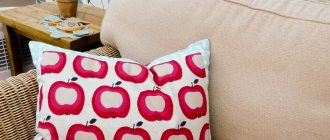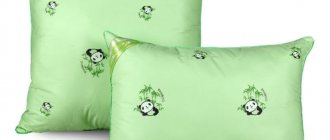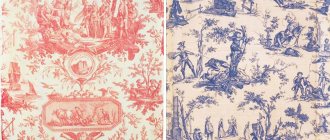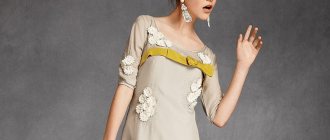Pillows as a bright style detail
A pillow is a symbol of a relaxing holiday, and the entire decor of Provencal houses is aimed at creating a calm, peaceful atmosphere. They are placed on beds, sofas, armchairs and even chairs in the kitchen - the more, the better.
Decorative pillows in the Provence style have their own characteristics:
1. Color scheme. Selected Provencal shades include white and beige, gray and blue, pink and light green, lavender and light yellow. The colors of the pillowcase should be reminiscent of those found in the landscapes of the south of France. Sometimes Provence style pillows are made double-sided. Plain pillows in the Provence style are complemented with trim of a different, but always harmonizing color.
2. Drawing. Most often used:
- Narrow and wide stripes.
- Plaid or pea.
- Floral patterns. The south of France abounds in flowers, so luxurious garden roses and lilies, delicate violets and daisies, verbena and lavender are found on textiles.
- Animal images. Pillowcases are decorated with drawings of roosters, geese, birds, butterflies, and dragonflies.
- Scenes from provincial life: a shepherd and a flock of sheep, a little girl herding geese, fishermen casting a net.
3. Decor of pillows in Provence style . Provence is a rustic style, so elements of handmade creativity will come in handy:
- Hand embroidery. This technique is used very often, because nothing can convey the atmosphere of family better than women’s handiwork.
- Handmade lace. Used as a decoration or as an element connecting different designs.
- Combination of fabrics. A common technique is when pillowcases are sewn in a patchwork style or fabrics with patterns and patterns of the same color are combined.
- Application. This technique is used for images of voluminous bouquets or animals.
- Flounces and frills. A pillow trimmed with flounces looks elegant and is softer to the touch.
4. Form. Decorative pillows in the Provence style can have a wide variety of shapes:
- The classic pillow is square or rectangular. Typically, tapestry or fabrics with patterns and embroidery are used for pillowcases of this shape.
- In the form of a roller. This shape is often used on sofas. The design most often comes down to rosettes of lace with a large matte button in the middle.
- Round or oval. This shape is bordered with wide flounces and a button in the center or edging in a circle.
- In the shape of a heart. Lace or ruffles are perfect for decoration.
You can buy Provence pillows that will perfectly suit your interior in the Lavender Decor online store. We also have a wide range of decorative pillowcases - from cute and simple models to those made using complex decorative techniques. The cost of decorative pillows in the Provence style starts from 790 rubles, but you can buy pillowcases for a price of 240 rubles! We will organize prompt delivery to any city in Russia (and Moscow residents will receive their order the very next day!).
Make your home cozier with decorative pillows from our store!
Go to the HOME TEXTILES section
This is interesting: Bed linen “KAZANOV.A” is one of the best. Description of collections
Color palette
Decorative pillows in French country style should match the overall color scheme of Provence. If you are selecting a product in a non-specialized store or looking for materials to sew decorative pillowcases for sofa cushions, follow these principles:
The French Provence palette includes a variety of airy pastel colors, permeated with strong, bright accents. You'll find lots of creamy whites and pastel shades of orange, yellow and red, accented with cheerful shades of gold, sage green, burgundy, blue. The range includes colors found in nature - it is not a style where decoration is achieved through the shine of metals and stones. Colors are often combined in unexpected ways, but the overall picture is never too bright or overwhelming. Just look at the beautiful bedroom in the photo above - the palette is muted, but there is nothing boring about it, the overall feeling is warm, joyful and calm.
Color solution
When choosing colors, you should give preference to the natural shades of the landscapes of Provence. Such as:
- white;
- beige;
- blue;
- salad;
- pistachio;
- lilac;
- pink;
- lavender;
- mint;
- light yellow.
Color palette in Provence style
Pillows are also double-sided. Then the main color on one side can complement the main color on the other side. The shades must overlap on each side and be combined with each other.
Making decorative pillows
The making of pillows should be taken seriously. Then you will be able to create products that exactly match the Provence style. It is necessary to choose the right material for the base and pillowcase, as well as decorative elements.
Suitable pillow material
Only natural material is suitable for production. It can be soft, gentle or rough. Depends on the chosen design direction. It is preferable to use the following types of fabrics: blue, cotton, linen.
Chintz
Chintz fabric with floral pattern
Advice! Before sewing, the fabric should be washed, dried and ironed. It will shrink, the initial length will change and acquire the final size.
Cotton (Coarse Type)
- This fabric looks like burlap, so it is ideal for a rustic style.
- The fabric is stiff and dense.
- It comes in gray or beige.
Coarse gray cotton for bedding
Important! Cotton also shrinks after washing. You need to pay attention to this before purchasing fabric in order to take the material with a reserve.
Linen
- The material has good strength and density.
- Pairs well with embroidery and lace, which serve as a wonderful complement to the rough base.
Thick decorative linen fabric
Important! Due to its natural nature, linen wrinkles quickly.
Padding
The material for stuffing should also be natural and environmentally friendly. These requirements are met by: down, goose feather, sheep's wool.
Down-feather filler is one of the types of natural fillers, consisting of a mixture of down and bird feathers.
Important! Each natural filler requires constant high-quality care and regular cleaning. If you are allergic to fluff or wool, you can choose an artificial material - padding polyester or holofiber. They are unpretentious in care, which makes them more profitable among other representatives.
Pillow options
There are many options for Provencal style pillows that you can make yourself. In addition to ordinary fabric products, you can sew felt pillows or simply knit them. More precisely, make decorations from felt and make knitted pillowcases.
Felt
Felt is a very practical, comfortable and interesting material. It can be used to create many interesting options for decorating a pillow. For example, use it as a base. Choosing colors suitable for Provence. You can also sew flowers, leaves, or animal silhouettes cut out of felt on top. Or use felt decorations on top of base fabrics (chintz, linen or cotton).
Homemade pillow with felt decoration in Provence style
Knitted
Knitted pillows add coziness and warmth to the interior. They pair perfectly with other knitted accessories. Emphasizes the rustic style.
Square knitted pillow in Provence style
You can knit a whole pillowcase, which you can exchange for another one in the future if you wish. Choose an interesting pattern. Pick up threads. It is best to use natural wool threads or acrylic ones. You can also knit interesting figures and sew them onto the finished product. It will look nice.
DIY decorative pillows: subtleties of materials
If you decide to make a decorative pillow with your own hands, you will need to stock up not only with ideas, but also with everything necessary to create it. First of all, you need to decide on the material. For this purpose, you can use fabrics intended for upholstery, as well as cotton, linen and even sometimes knitwear (be careful: the material is quite capricious). In addition, denim, felt, fleece and canvas are perfect for creating a pillow.
Colorful pillow made of bright felt petals
Composition in the form of the British flag: a combination of jeans and red chintz
Luxurious fur and leather cushions
Stylish and original knitted pillows
Advice! Sewing pillows from old favorite clothes is also a great creative idea.
An interesting solution to using old things
Harmonious combination of fabrics in the decor of home accessories
Original pillows from unwanted clothes
You can hardly do without a combination of different fabrics in this process, so make sure that fabrics that do not stretch do not combine with stretch fabrics, otherwise after stuffing you may end up with something shapeless rather than a pillow. If you know how to knit, then this skill will be a great bonus, because knitted pillows look quite stylish and unusual. Yes, and try to use fur: short pile or long - it’s up to you, as long as it doesn’t fray.
Large knitted pillow for handicraft lovers
Using old clothes to decorate upholstered furniture
What is “Provence” and how does it manifest itself?
Provence - the style of French villages. This is a break from the bustle of the city and the desire to feel in harmony with nature. Its main features are freedom and maximally bright open space. The Provence style is used to decorate any room - be it a kitchen, living room or bedroom.
Home textiles in the Provence style are distinguished by:
- Natural unobtrusive motives;
- Lovely harmonious details;
- Aged furniture;
- Natural materials.
Natural light colors;
It seems easy to create this simplicity, airiness and lightness. However, to achieve naturalness, painstaking work is needed and therefore every little detail is important. If at least one piece of furniture differs in style and focus, the overall appearance of the room will deteriorate. It’s not for nothing that they say that the most difficult thing to create is beautiful “naturalness” than alluring chic.
Decorative pillows are an accent in "French country". Without them the image would not be complete. Pillows are placed on beds, sofas, armchairs and chairs. They come in different sizes and shapes, but there must be a lot of them. This is no accident. The pillow is a symbol of calm and relaxation. Namely, these features are inherent in style.
DIY decorative pillow covers
Styling covers to resemble flowers and bouquets is an original solution. Covers, or pillowcases, will be an excellent decoration. Ideas for decorative covers:
- One large flower on a contrasting background. Each petal is cut out, its edge is processed, and the center and petals are sewn onto the base. Such a voluminous pillow will be an accent in the room.
- Bouquet. You can sew several flowers on a pillowcase in the form of a bouquet. The easiest to implement are rose buds.
- Flower meadow. In order to “plant” it, you need a fairly large base, that is, a ready-made pillow. Here it is better to use small flowers and supplement them with leaves, grass, or even bugs. It all depends on the style of the room for which the pillow is created.
- Embroidered flowers. Moreover, embroidery can be done flat (satin stitch or cross stitch) or with ribbons.
“Delicious” soft pillows in the shape of watermelon slices
DIY Provence style bedspread
Textiles in the Provence direction play a key role in interior design. Without a bedspread, any bedroom will not look furnished and cozy enough. This detail is very important, since it is its large dimensions that people pay attention to first. A little later we will look at a simple way to make a Provence-style bedspread with your own hands. In the process of working, we will make ordinary knots as decoration, which will become the highlight of this product.
Basic principles for selecting textiles in Provence style
The most important thing here is not to make a mistake when designing a bedroom bedspread in Provence style. To do this, you need to know some points about selecting a fabric or bedspread for its manufacture:
- Room size. This is the main criterion for selecting a Provence style bedspread for a bed. If the sleeping area occupies more than 50% of the total area of the room, then the color of the blanket should match the furniture and walls.
- Lighting. The next indicator is the selection of textiles for the room. So, for example, if the bedroom is poorly lit by natural daylight, then there is no need to choose a dark-colored bedspread to avoid a gloomy appearance. The use of cold colors is also undesirable, since they are not able to create that very favorable aura and homely atmosphere that should reign in the Provence style.
- Choose images that are pleasant to you for a bedspread in the Provence style, that you like and do not irritate you.
- When choosing a bedspread, be guided by the color of the wallpaper and curtains in the bedroom.
Materials and tools:
- 56 pieces of cotton fabric (size 45x45 cm).
- Any plate with a diameter of 15 cm.
- White threads.
- Needle.
- Sharp scissors.
We sew a bedspread in Provence style with our own hands:
- We apply a plate to each fabric square, and then outline the contours. We sew the outlined circle with a simple seam forward with a needle.
- We tighten the thread, collecting the fabric from all sides in the form of a lump in the very center of the square. We do not break the needle and thread, but leave it attached for now.
- We press our finger on the top of the collected lump and thread it to the wrong side. We return the knot from the wrong side so that on the front side we get a beautiful and neat knot.
- We fix the knot with thread until it takes one constant position.
- We perform similar actions with all the other squares, tying identical decorative knots on them.
- We sew the finished fabric pieces with knots together, forming one whole bedspread in the Provence style.
- We sew the previously made patchwork onto thick fabric.
Important! If you used very thick textiles to create a bedspread with knots, then you can skip the last step and lay the finished product on the bed.











